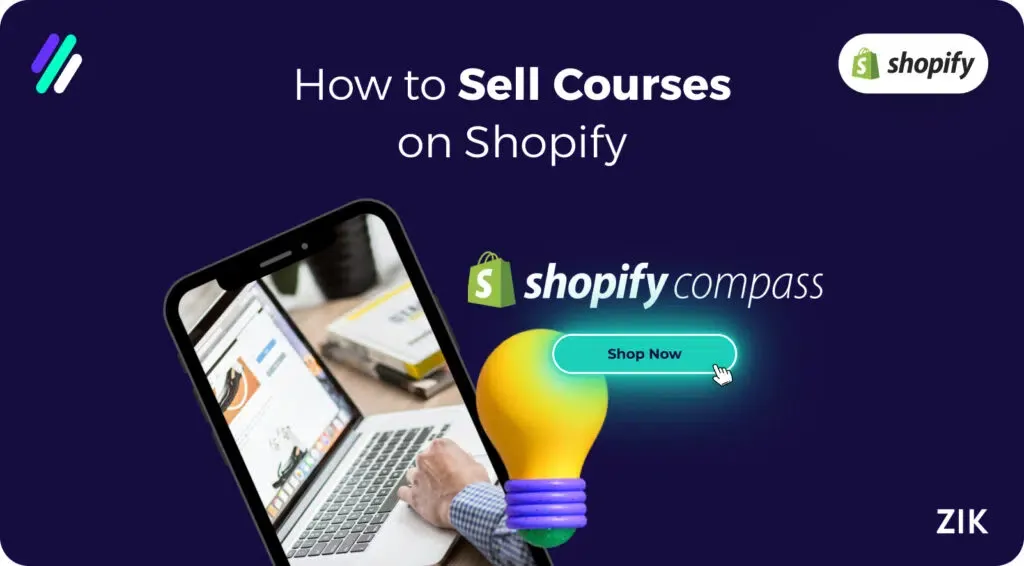Looking to sell courses on Shopify? In the ecommerce space, there is no limit to what you can sell online. The only limit is your imagination. Such is the case when selling digital products.
If you’re curious about demand, using a Shopify sales tracker can help you see which digital products are already performing well. That way, you validate your course idea before putting in the work of creating it.
You can produce any digital product as long as there is a market for it, and it could help generate a steady income revenue stream.
If you’re looking for a passive income, it’s even better because there are no physical products to manage an inventory for, package and ship to a customer’s location.
Selling online courses is not an entirely novel idea on Shopify. However, it has taken off in the last few years, especially during the pandemic when online learning became the norm.
And if you want to sell online courses on your Shopify store, it’s a flourishing business idea with lots of income potential.
This guide on selling courses on your Shopify store is your ultimate resource in this niche! Uncover the best strategies for selling courses on Shopify and get pointers on how to create courses correctly.
Let’s get to it!
Key Takeaways
- A growing demand for online courses makes it a profitable business idea for a Shopify online store.
- Perform market research and analyze your target audience to determine the best content idea for your online courses.
- Set up an online store with Shopify and build a landing page for your online courses.
- Employ various digital marketing strategies to attract prospective customers and students to your online courses on Shopify.
Why Sell Courses on Shopify?
Before diving into strategies for selling online courses, let me share my thoughts on why I believe selling an online course is a profitable business idea for your Shopify store.
The online courses market is booming globally. And that means you can earn $500 to $5,000 per month, depending on your niche and target market. According to the State of Creators ’24 Report, 40% of the top-earning course creators earn a six-figure income within two years.
It’s difficult to pinpoint exactly how much you can make when selling digital courses on Shopify, as it depends on the price of the course, the type of course, and its relevance. It also depends on whether you have a loyal customer base or not. If the former applies to you, your audience is likely willing to pay more for quality courses.
The niche of the online course tends to impact your earning potential. Those within the technology, marketing and finance spheres tend to command the highest prices, while modest and lifestyle courses command a moderate earning potential.
Benefits of Choosing Shopify vs Other Online Course Platforms
Let’s say you already have an online course. Why sell courses on Shopify instead of other more popular platforms, such as Udemy or Coursera?
These platforms are clearly popular, and they have become the go-to choice for anyone looking for an online course.
These reasons show the benefits of setting up an online store with Shopify to sell courses.
1. You Maintain Full Ownership and Control
Let’s start with the most important reason for selling an online course with Shopify: maintaining full ownership and control.
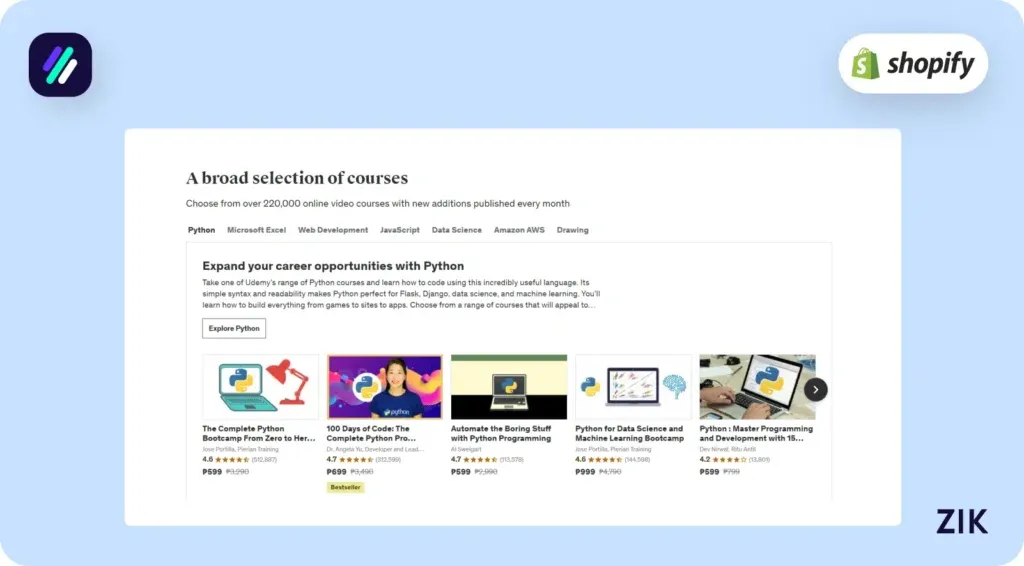
When you sell via Udemy or Coursera, you must adhere to the platform’s strict guidelines. You also have to agree to their revenue-sharing models, so you do not receive all the money you earn for each course you sell.
On the other hand, creating a Shopify store dedicated to your online courses gives you full control. You can build an online store reflecting your brand or personalizing the course experience for your students.
Since your online courses are readily available on your online store, you can set prices that reflect the value of your course. And the best part is you get to retain all the profits!
2. Access to e-Commerce Features
Selling courses on Udemy or Coursera means you can utilize a limited functionality or use whatever tools are available on the online course platform. With a Shopify store, you can integrate various e-commerce tools that allow your online business to thrive.
Once you set up your ecommerce store on Shopify, you can access ecommerce tools, such as customer management, sales tracking, and marketing. Shopify offers tools that enable you to create discount codes or bundle courses to maximize sales and make your online courses more attractive to prospective customers.
3. Integrations
A Shopify ecommerce store offers seamless integration with various third-party Shopify apps and services for selling courses on Shopify. Whether you need help with course creation or selling access to your online and video courses, you can find an app that provides your desired functionality.
The Shopify app store provides endless options for your business needs or potential customers.
4. Scalability
The main reason for selling courses on Shopify versus other online course ecommerce platforms is the ability to scale your business.
As your business grows and you experience high demand, your offerings can be expanded to include other products, such as selling access to video courses, digital downloads, audio files, tutorials, subscriptions, and more.
You can adjust your business model according to the evolving needs of your prospective customers or target market.
5. User-Friendly
Even if it’s your first time creating an ecommerce store with Shopify, you’ll find a minimal learning curve. Once you have set up your account, the Shopify admin dashboard provides all the tools you need to run your online store and start selling courses.
It is highly intuitive, and you can customize the look of your Shopify store with interactive elements or customize the store’s design with various themes.
Selling Courses as Digital Products
As I’ve discussed previously, selling digital products is allowed on Shopify. And online courses are among those digital products that Shopify allows on its platform.
When you sell an online course on Shopify, it’s basically like selling physical products. You must set up a new product and add relevant information, such as the course title, course description, and pricing information.
Creating a landing page specific to your course on your Shopify ecommerce store is important. Once your landing page is set up, you must choose from many Shopify apps as an online course platform to easily enroll anyone interested in your course.
Shopify offers seamless integrations with these course apps and platforms, ensuring that your customers won’t have any issues accessing the course after downloading it from your website.
How to Sell Courses on Shopify
Now that you know why selling courses on Shopify is a profitable venture, it’s time to start selling those courses!
Here is a step-by-step guide to help you achieve success.
Step 1: Course Creation
Before you can get to the process of selling courses online, creating online courses is the most important decision – and difficult – part of this process. You don’t have a product for your ecommerce business without the course creation process.
When you create online courses, take time to evaluate your skills and expertise.
What knowledge or skill do you have that is valuable to others?
What competencies will attract potential customers?
Assess your level of expertise, years of experience, and credibility (such as certifications and licenses) to ensure you have the qualifications to create online courses within a specific niche.
Your audience wants to know that you have the credibility to discuss a particular niche or topic when selling online courses.
Therefore, always consider your expertise during the content creation process to help you create a product that will stand out.
Step 2: Research Your Potential Customers
Once you have a topic for your online course, research your target market to determine what they are looking for.
The best place to start is Google Trends, where you can get real-time information on trending topics and search queries. You can narrow down your search according to a niche or topics within a specific period (such as in the last 30 or 7 days).
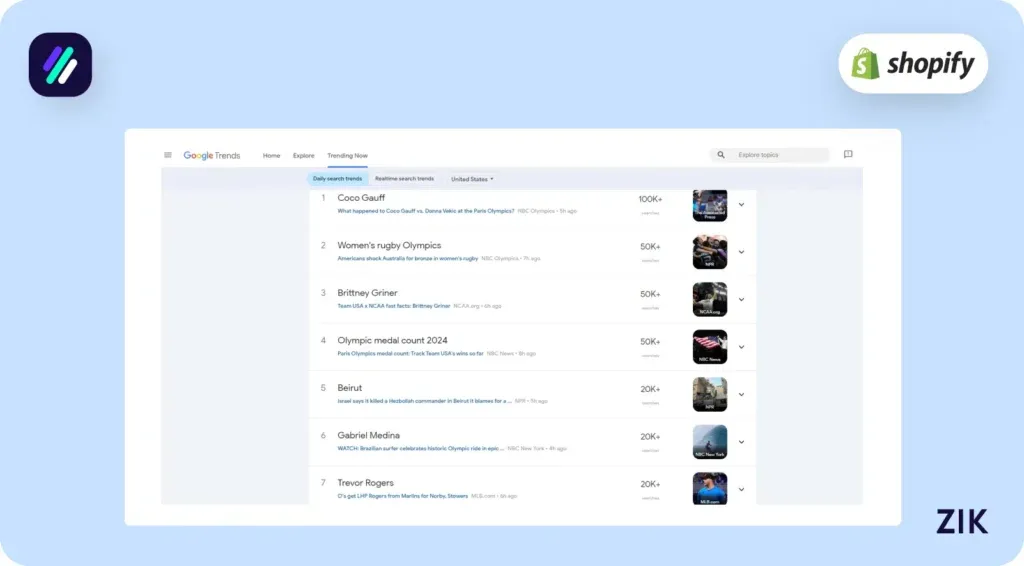
You can also use other product research tools, like ZIK Analytics, to determine trending niches, products, and keywords. This is an excellent way to get ideas on trending topics and what your customers want.
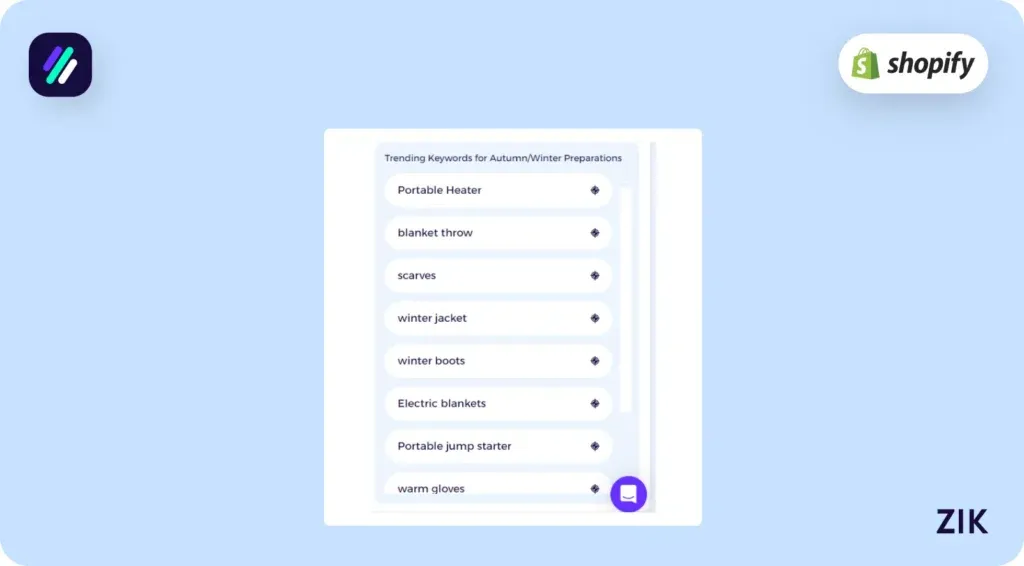
Or better yet, go to Google and input a keyword or search term. It will suggest what specific information your audience seeks about a specific topic.
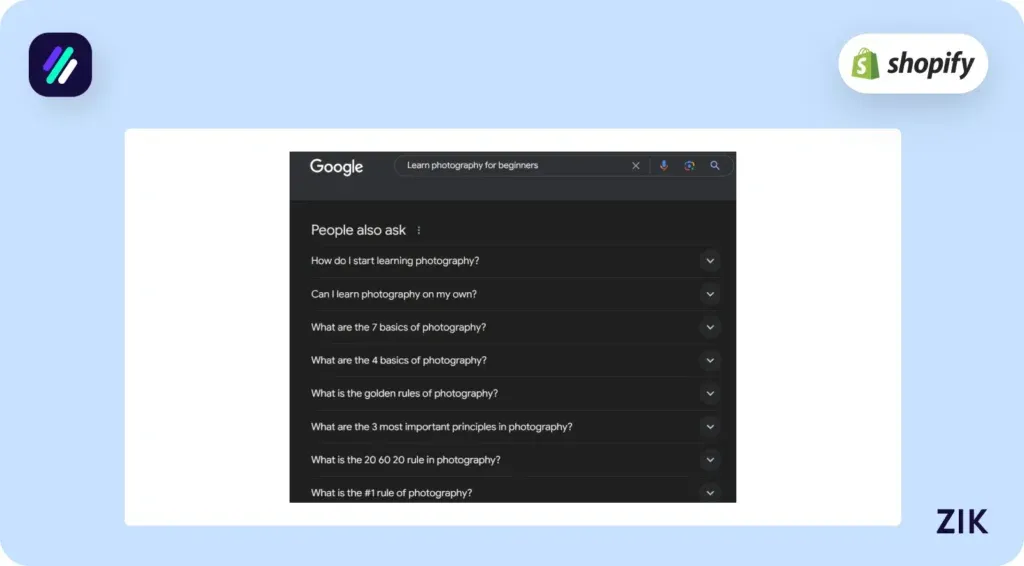
Use the information you’ve gathered to build a cohesive and high-value product.
Step 3: Break Down Your Courses into Chapters
When creating online courses, break down a comprehensive topic into several easy-to-digest chapters. This approach offers two benefits.
First, it gives your audience the opportunity to digest information easily, especially when the online course deals with a major topic. You can offer digital courses in numerous lessons they can download at once or as they become available.
This also makes learning easier, as it allows students to allocate time for every lesson before moving on to the next.
Another benefit is that you can ensure customer loyalty because they will likely purchase the succeeding lessons in your course once they complete the previous ones.
It guarantees that you have a steady stream of income from selling online courses, provided that you have a product of high quality and value that would bring them back to your online business
Step 4: Choose the Right Online Course Format
There are many online course formats available, and you can choose according to what fits your course type or niche. When choosing a format, consider the course size and the time it takes to consume the course content.
An online course format could be either one of the following:
- Mini Courses – A mini course is smaller in size and content because it introduces a more comprehensive lesson. It is a common strategy for an ecommerce entrepreneur to give these mini courses away for free to generate leads for their online business. For it to be effective, mini courses should offer as much value as a full course. Maximizing the impact of this tool on your ecommerce business sales funnel should be of equal value.
- Multi-Day Course – Another example of a course format is a multi-day course. As the name implies, completing the entire course takes a few days to several weeks. It should be delivered in multiple courses instead of one extensive course.
- Masterclass—This is the most extensive online course format and focuses on a specific topic or subject matter. In theory, a masterclass involves up to 60 hours of learning, starting from the basics to the complex aspects of the lesson.
Step 5: Choose an Online Course Platform
Knowing where to sell online courses is as critical to your success as the content creation process. While many course creators use a learning management system to sell courses, setting up your ecommerce business website in Shopify will allow you greater scalability and profitability with your business.
One downside to using Udemy or other similar online course platforms is the immense competition with other online courses within the same platform. On the other hand, it would be easier to market your online courses when selling them through your Shopify store.
You can customize your store theme to suit your niche, allowing you to establish your brand. The Shopify Theme Store offers free and premium themes that allow you to create a website focused on promoting your courses online.
These themes are organized into categories that simplify the theme selection process.
In addition, you can choose any payment gateway for your online business. Whether you want to enroll with Shopify Payments or choose another payment gateway, getting paid for your online courses becomes easier.
Since Shopify Payments or another trusted payment gateway offers encryption, it assures potential customers that their personal and financial information is safe, giving them more reasons to choose your online course.
Another thing worth mentioning when you offer online courses through your ecommerce business website on Shopify is the opportunity to customize the user experience. You can give customers the option to contact you via phone or email if they have any inquiries about your online courses.
Integrating third-party Shopify apps, such as Shopify Inbox, allows you to communicate with your audience so you can manage conversations with ease. It also gives your customers confidence in knowing that you are a legitimate ecommerce entrepreneur who offer online courses on a legitimate platform.
If that’s not enough, you can add a blog or FAQs section to your ecommerce store. Simplify the process of finding information about your online courses to help your customers better understand the value of your digital products.
Step 6: Build Your Landing Page
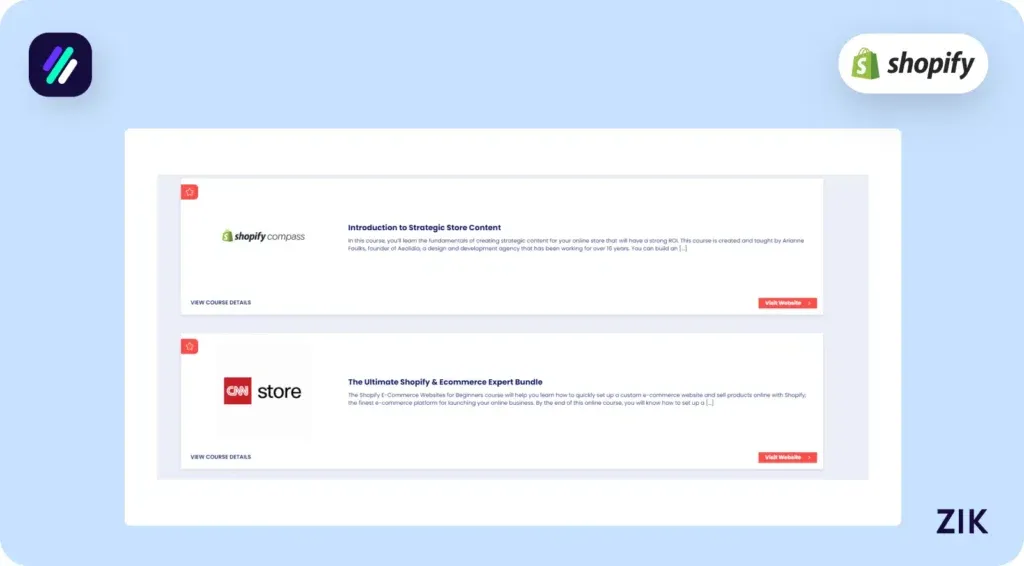
As mentioned, it is crucial to have a landing page if you offer online courses on your ecommerce website.
While I’ve already mentioned that Shopify is an intuitive website builder that allows you to customize the theme and functionality of your website for enhanced user experience, it’s worth mentioning that there are page builder apps that make your landing page more useful and interactive.
Whether you choose a custom font for your online courses page or tweak your mobile site, invest in building a compelling landing page.
This page is essentially where your prospective customers learn about your course idea and get their first glimpse into the course content. Make it interactive, informative, and useful for them.
Step 7: Pricing Your Online Courses
An important step before you start selling online courses is to determine the price for your courses.
Whether selling digital or physical products in your Shopify store, developing a solid pricing strategy is always crucial to your success. This is especially true given the level of competition in today’s online course marketplace.
For content creators, your natural inclination is to price your online course as high as possible due to your perceived product value.
Pricing your online courses can be risky. If you price them too low, the perceived value of your course will decrease significantly. If you price them too high, you will lose out on sales, as your customers will be looking at other courses.
Resist the temptation to charge your courses too low at the start. Set your baseline price higher than you would think, especially if you’ve researched the target market and validated your content idea.
You developed your course using your knowledge, expertise, and time. To make it worth your while, set the baseline price for a course at not lower than $100.
It is riskier to set your online course prices too low because it makes your audience lose interest in the product, assuming that it has lesser value than what the course content can offer.
You always have the option to reduce the price when selling online courses later through promotions and discount codes. It is easier to offer a lower or discounted course price than raising it unless you add something of value to the original product.
What are the other benefits of pricing your online courses high at the start?
- It allows you to reach your sales goals faster.
- It weeds out potential buyers who might not be interested in your course.
- It boosts engagement and the perceived value of the course.
- It allows you to target a specific, more engaged audience.
Step 8: Marketing Your Online Course
Here is the fun part of selling online courses on Shopify: marketing your online course.
You can employ various marketing strategies; it is recommended to use a combination of marketing strategies, such as email marketing and social media marketing.
Once you set up your website, you can start sharing about your online courses on your social media platforms to attract prospective customers. Participate in Facebook groups to find like-minded individuals who might be looking for your specific type of course content. These spaces also give you additional ideas on the future content idea for your courses, allowing you to conduct market research while promoting your course.
As I’ve mentioned, email marketing is a great way to promote your online course. You can offer mini-courses or products on your website to get people to sign up for your mailing list.
Send newsletters and email marketing to share promotions and limited offers to maximize student engagement. As a course creator, you can also use email newsletters as a platform to enhance the students’ learning experience by sharing helpful information available only to your email subscribers.
Conclusion: How to Sell Courses on Shopify
Setting up a Shopify courses website is a profitable business idea that you should pursue, especially if you have a valuable course idea.
Every savvy entrepreneur should take advantage of the rise of digital products in high demand. Once you master these techniques, you can experience more success selling courses online on Shopify!
Start Selling Your Courses on Shopify with Confidence
Ready to start selling courses on Shopify? The key is pairing great content with smart validation. By checking what sells best through a Shopify sales tracker, you can position your course for success and avoid dead ends. Launch with confidence, knowing there’s a proven market waiting for you.













